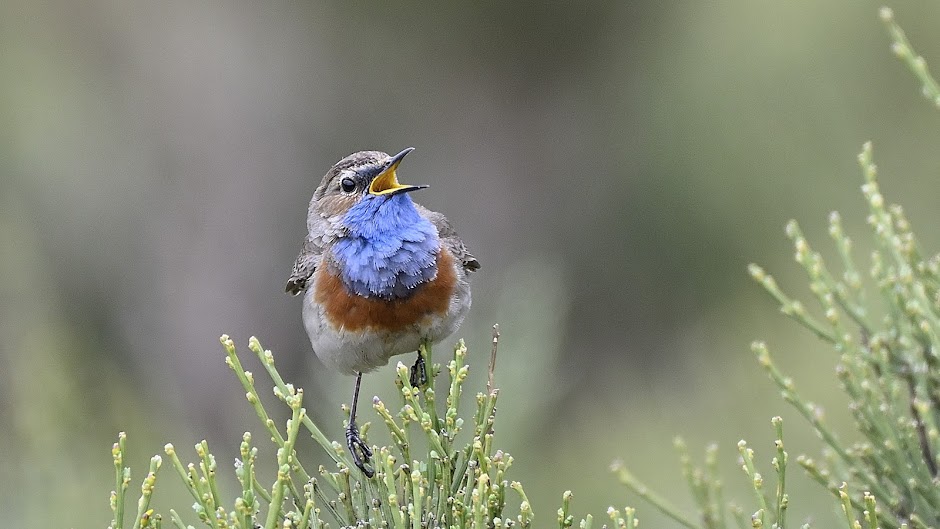Hola una vez más.
Hi again.
Como habréis adivinado por el título en esta entrada os muestro lo que he tenido la suerte de observar de la berrea en Madrid y la cantidad de aves en paso que he observado este año, mayor que en otros años o eso me ha parecido a mí.
As you may have guessed from the title in this post I show you what I've been lucky enough to observe the rut at Madrid and the large number of birds in pass I have observed this year. Higher than other years or at least has seemed to me.
El primer día que fui había habido una tormenta la noche anterior y me imaginé que los venados estarían ya en celo. La verdad es que disfruté tanto viéndolos que he ido un par de veces más y me ha parecido oportuno enseñaros lo que he visto para aquellos que no la hayáis disfrutado. Es una pena que no pueda transmitir el sonido que hacen los machos en celo.
The first day I was there it had been a storm the night before and I figured Deer would already be in heat. The truth is that I enjoyed so much that I've returned a couple of times and have found it appropriate to show you what I've seen for those who do not have the opportunity to enjoyed it. It's a shame I can not transmit the sound males make in season.
Comencemos por las especies de aves que he visto en paso en mis visitas a ver la berrea.
Let's start with the bird species I've seen in pass on my visits to see and hear the rut.
Macho adulto de colirrojo real (Phoenicurus
phoenicurus).
An adult male of Common
Redstart.
Macho de primer invierno de colirrojo real (Phoenicurus phoenicurus).
First winter male of Common Redstart.
Tarabilla norteña (Saxicola
rubetra).
Whinchat.
Papamoscas cerrojillo (Ficedula
hypoleuca). Increíble la cantidad que se han dejado ver por la Comunidad de Madrid.
Pied
Flycatcher. Amazing the amount seen by the Community of Madrid.
No tantos pero también abundantes fueron los mosquiteros musicales (Phylloscopus
trochilus).
Not as many but also very abundant were the Willow Warblers.
Collalba gris (Oenanthe
oenanthe). Esta especie se reproduce en las zonas altas de la Comunidad pero en la época de paso se la ve por muchos más lugares.
Northern
Wheatear. This specie breeds in the highlands of the Community but in the time of pass is seen by many more places.
Mientras que unos están en paso otros ya están llegando. Este es el caso del petirrojo (Erithacus
rubecula).
While some are in pass others are arriving. This is the case of the Robin.
Entre los residentes pude observar a las sonoras cotorras argentinas (Myiopsitta
monachus).
Among residents I observed the noisy Monk Parakeets.
Y un zorzal charlo (Turdus
viscivorus).
And a Mistle
Thrush.
Un bonito lagarto ocelado (Timon lepidus).
A beautiful Ocellated Lizard.
Busardo ratonero (Buteo buteo).
Common
Buzzard.
La majestuosa águila imperial ibérica (Aquila
adalberti). En la foto un adulto.
The magnificent Spanish
Imperial Eagle. In the picture an adult.
Joven de águila imperial ibérica (Aquila adalberti).
Juvenile of Spanish Imperial Eagle.
Impresionantes.
Awesome.
Buitre leonado (Gyps
fulvus).
Griffon
Vulture.
Buitre negro (Aegypius
monachus).
Monk
Vulture.
Los gamos (Dama dama) se reúnen debajo de las encinas para comer las esperadas bellotas.
The Fallow Deers gather underneath Holm Oaks to eat the expected acorns.
Aunque ya he podido escuchar algo de ronca el celo de éstos es más tarde que el de los venados (Cervus elaphus).
Although I could hear some hoarse, the season of these is later than of the Red Deers.
Bonito macho.
Beautiful male.
Y por fin los esperados ciervos (Cervus elaphus).
And at last the expected Red Deers.
Una imagen que no había contemplado nunca, unos rabilargos ibéricos (Cyanopica
cookii) posados en una cierva.
An image I had never seen, some Azure-winged Magpies perched on a deer.
Un rabilargo ibérico (Cyanopica cookii) en plena muda.
A molting Azure-winged Magpie.
Algunos cervatillos aún estaban mamando.
Some fawns were still suckling.
Un macho más joven que el anterior.
Younger than the previous male.
Una cierva curiosa y muy mansa me entretuvo durante un buen rato, o yo a ella.
A curious and very tame doe entertained me for a while, or I to her.
Hermoso animal.
Beautiful animal.
Al igual que este otro.
Same as this one.
Este macho no paraba de zarandear las ramas de las encinas para poder comer las bellotas que se desprendían.
This male kept shaking the branches of the Holm Oaks to eat the acorns that fell down.
Inteligente, ¿no es cierto?
Smart, isn't it?
Un cervatillo bastante pequeño para esta época del año.
A fairly small fawn for this time of year.
Aun me parece estar oyéndolos.
I still seem to be hearing them.
Y con estas bonita imágene me despido de todos vosotros hasta la próxima entrada.
And with this beautiful image I leave you all until next post.



































































Muy bonitas
ResponderEliminarMuchas gracias Oscar. Me alegro que te hayan gustado.
Eliminar